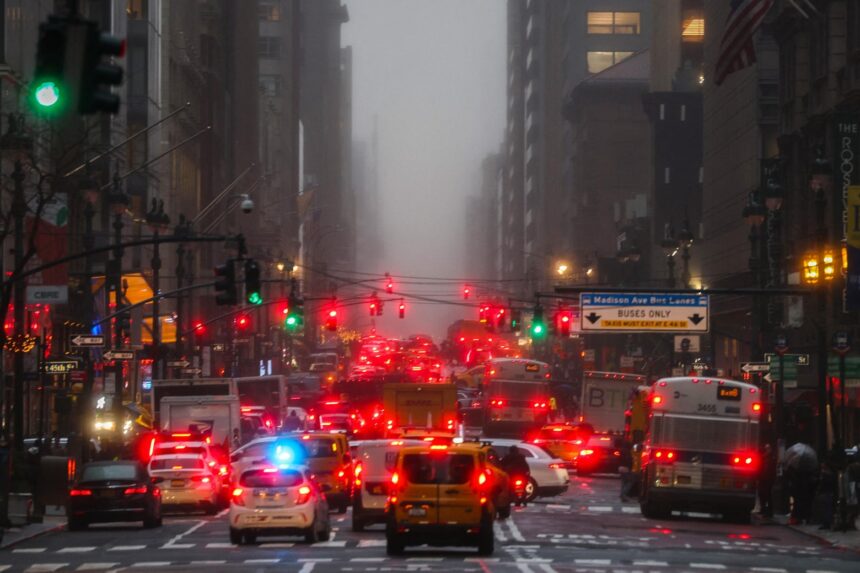New York politicians are at it again—and by at it I mean they’re pulling off stupid self-owns based on weak, thin justifications. On Wednesday morning, just days before the end of New York’s current legislative session, Gov. Kathy Hochul made the shocking eleventh-hour announcement that her administration would “indefinitely pause” implementation of New York City’s congestion-pricing program. The policy, which has been in development since 2019 and was supposed to go into effect by the end of this month, would have made New York an American pioneer in utilizing a successful, popular model deployed in many European cities to charge car commuters a premium to drive into the city center. The goal: reduced traffic congestion and lowered carbon emissions. Revenues from the program would then fund sorely needed fixes to New York City’s transit system.
Hochul was just touting the benefits of congestion pricing two weeks ago, but she appears to no longer see things that way. According to a Tuesday night Politico report, House Minority Leader Hakeem Jeffries started raising his concerns with Hochul, claiming that if the plan were to go into effect during this election year, the ensuing buzz could make it harder for New York Democrats to win back the House of Representatives. The proposed $15 fee for drivers heading into lower and midtown Manhattan—whether from the outer boroughs or from the broader tri-state region—remains unpopular with the types of wealthy, swingy suburban voters national Democrats need on their side. And considering how badly New York Dems botched the 2022 midterms, losing House seats that could have cut into Republicans’ narrow majority in the chamber, Jeffries would like to do anything he can to regain those seats—including mollifying the New Yorkers who own cars only because they make it easier to flee to the Hamptons. Hochul herself says her decision is based on concern that congestion pricing might deter people from heading into Manhattan at a time when the city is still recovering from COVID-era business losses.
Now, as a registered voter and public transit rider in New York City, let me say this as clearly, thoughtfully, and delicately as I can: This reasoning is poppycock, hogwash, and bullshit. It will leave the city worse off, rob the entire country of a chance to witness a pioneering climate solution in action, and hardly warm anyone to Jeffries, to local Democrats, or even to the widely disliked governor herself.
Yes, I’m aware that polls show that congestion pricing is unpopular in NYC, that both the state of New Jersey (whose underfunded transit system infamously sucks) and the leaders of the teachers union are suing to block the plan, and that Donald Trump is already using the issue to campaign against Dems. But let’s take a look at some facts and figures surrounding the actual effects of congestion pricing, shall we?
After all, congestion pricing wasn’t invented in City Hall just to demonize certain New Yorkers. The policy has been successfully implemented across the globe, in places like London, Stockholm, Singapore (the first in the world to do it, back in 1975!), and Milan. Even in those cities, the proposal was unpopular at first but gained mass favorability after it was enacted. It’s easy to see why, given the results: less intense traffic, fewer deaths by collision, more space opened for alternative transportation like bikes and buses, more money for essential infrastructure, reduced carbon emissions—and an overall happier and safer populace.
Back in 2007, even then–Republican Mayor Michael Bloomberg trumpeted congestion pricing as a way to reduce traffic and carbon pollution. Although the proposal failed to take off then, the NYC transit crisis in summer 2017 convinced subway officials that congestion pricing would be needed to aid the ailing infrastructure, much of it still damaged from the wreckage of 2012’s Superstorm Sandy. Gov. Andrew Cuomo signed on, but the program still took forever to get off the ground: state legislation, environmental reviews, public comments, federal approval (which came only under the Biden administration), transit-authority sign-off—classic bureaucracy, you get it. Diligent teams of researchers, traffic and transit experts, and city officials worked tirelessly to plan the version of the program most likely to make the city a better place for all. Finally, after getting through every one of those hoops, the United States’ first congestion pricing plan was finally set to roll out this month. A complex network of cameras, installed under the terms of a $500 million–plus contract, stands arrayed along 60th Street, ready to begin a real-time experiment that would have been of great interest to myriad other cities working to reduce traffic gridlock, raise funds, make streets safer for everyone, and lower emissions, all in one fell swoop.
That is, until Kathy Hochul bailed on it. Why believe the experts? She has just got a feeling that it might be bad for New York and its Democrats. Here’s the thing, though: It’s not only lefty environmentalists mad about this. Long Island’s own local columnists are furious! The Daily News editorial board is outraged! Local business leaders and developers are vocally upset! Everyday subway riders don’t know how the service they depend on will ever be fixed! There is no proof whatsoever that this will be of benefit to New York Dems come November—if anything, it may actually backfire by pissing off various interest groups and constituents, while feeding Republicans a gimme attack line about Hochul’s two-step. What does she or any Democrat really believe in if they’re such pushovers?
But New York isn’t Europe, critics say. And more people use cars to commute here anyway, including poorer and disabled folks. We should be imposing other taxes instead! Let me direct you to Hell Gate’s Christopher Robbins, who reviewed the literature and uncovered some facts that may surprise you:
Wow, that’s a lot of mass-transit use! It would be nice if we had a good revenue stream to support those trains and buses, especially for poorer and disabled New Yorkers, huh? Especially since Kathy Hochul is steadfast in her refusal to raise taxes on any of New York’s wealthiest and is ready to gut social programs just so those outer-borough cops can keep getting their fancy SWAT gear and copious overtime. Seems only fair to have such taxpayer-supported public officials pay their fair share too, no?
Additionally, the program as originally planned is very literally a carefully focused tax on the biggest, most congesting vehicles, and on the richest drivers. There is a “Low-Income Discount or Low-Income Tax Credit” for which poorer drivers who do need their cars can apply. Emergency vehicles like ambulances, specialized transport for people with disabilities, school buses, and commuter vans would also have been exempt from the fees. For the rest of ya: Motorcycles are only $7.50, cars have a $15 fee, and trucks of varying sizes would cost anywhere from $24 to $36. I don’t know—seems like a good way to get people to use public transit or, at the very least, hop into a smaller vehicle.
As for Hochul’s baffling claim that this would keep people from New York? Buddy, it’s literally New York! As long as Lower Manhattan still has tourist attractions and recreational options of the type you just can’t get in New Jersey and Connecticut (no shots, but it’s true), people will always be streaming into the city, and they’re going to be perfectly fine paying $15—three-fourths the price of a martini in Soho—to do so. That is, unless more climate-changed storms like Sandy shellack Manhattan because we didn’t employ enough solutions (like congestion pricing) to lower our emissions or raise enough funds to future-proof the city. I’m sure New York Democrats will be so much more popular then.











